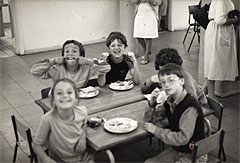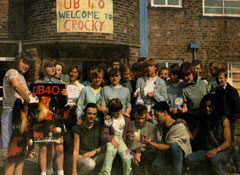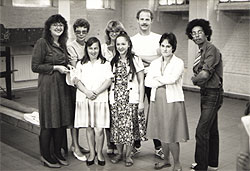
| HOME |
| NERVE |
| REVIEWS |
| ARCHIVE |
| EVENTS |
| LINKS |
| ABOUT US |
| CONTRIBUTORS |
| BACK ISSUES |
| CONTACT US |
 21
years ago in Croxteth
21
years ago in Croxteth
It’s now 21 years since the Militant-run Labour Council came to power in Liverpool on a wave of hope and aspiration. These were the dark days of Thatcherism, of mass unemployment and of protest. Two Liverpool school occupations, Croxteth and Harrington, ended in this year (1983). Both were inspiring examples of Community Action, breaking new ground with the participation of parents, teachers and pupils in running their own schools.
The Liberals put forward a plan to close Croxteth Comprehensive School (Crocky Comp) in late 1980. The Liberals, who had no overall majority in the council, relied on the Tories to push closure plans through. Parents and staff were angry at not being consulted and saw this as a cowardly act because original plans for schools’ reorganisation, due to falling pupil numbers, had not included Croxteth. Ellergreen School, two miles away, was to take the displaced pupils.
Living conditions in the area were described as ‘appalling’ by a Social Services report in 1983, with 90% of 16-23 year-olds having neither parent working. Croxteth Comp was the only non-denominational secondary school on the estate. Local people, with hardly any other facilities available, viewed it as a real asset. Croxteth was a Labour controlled ward, whereas Ellergreen was situated in Clubmoor where Mike Storey, Chair of Education, was a Liberal councillor. The closure plan was seen as political, with developers ‘drooling’ over its 32 acres of playing fields.
Parents and teachers started the campaign to save the school with letters and petitions. But when, in November 1981 Keith Joseph, Secretary of State for Education, approved the closure plan, the campaign to save ‘Crocky Comp’ took to the streets. Acts of ‘Civil Disobedience’, such as the blocking of the East Lancashire Road and the occupation of the Liverpool Echo offices, created publicity and generated interest. There was no withdrawal of the closure notice though. So on 13th July 1982, the day before closure, the community occupied the school.
It was suggested early on in the occupation that the school should restart with the aim of bringing it back under local authority control. This was an historic step in British education. A summer school was run as a pilot scheme to encourage the community and keep the campaign on the boil. Arts groups were invited in, and the BBC produced a programme about the occupation. UB40, on tour in Liverpool, came up, but couldn’t perform because the electricity had been cut off, although pupils were later bussed to their concerts for free.
 Funds
were raised in collections and the trades unions gave money, and a liaison
committee was set up. The Autumn term started with 350 pupils on the first
morning, settling down to about 200. An appeal had gone out for qualified
volunteer teachers to staff the school and they came, one from as far
away as Edinburgh!
Funds
were raised in collections and the trades unions gave money, and a liaison
committee was set up. The Autumn term started with 350 pupils on the first
morning, settling down to about 200. An appeal had gone out for qualified
volunteer teachers to staff the school and they came, one from as far
away as Edinburgh!
Caning was abolished, uniforms were not required and pupils set up a school council – voting that the teachers should be paid! Parents, who had been running the 24-hour occupation, cleaned and cooked (all meals were free at first, then rose to 10p) and also took on administration and even some teaching. It took £500 a week to keep the occupation running. The sacrifices made by the community were ‘tremendous’. The occupation had become “organic – alive, with the community flowing in and out of the school.”(1)
There was a continual financial crisis and the occupation had to cope with ‘dirty tricks’. The council wrote to parents threatening them with prosecution if they didn’t send their children to other schools, and councillor Richard Kemp made the outrageous comment that: “what is needed is more parental responsibility and a few clips round the ear.”(2)
Of course the ‘gutter press’ ran virulent anti-occupation stories and The Daily Mail even sent a spy in who ‘reported’ that, “the strange Indian cult Anada Marga” (3), was at work in the school.
‘Crocky Comp’ had become a beacon for resistance to school closures throughout the country. Other school occupations had broken out, notably in Birmingham. The Croxteth campaign, which had started as a local issue, was now national, with the realisation that it could only be won with the support and involvement of the wider community.
One of these new occupations was at Harrington School in the Dingle, known locally as ‘Harry Board’. Three primary schools in this area had been issued with notice of closure (an action later declared illegal by Tory Central Government). All three were to be re-located on grounds below the Anglican Cathedral, and the new school was to be called ‘Cathedral School’. £40,000 was spent on architect’s fees. Then there was a sudden change of mind by the Liberals and the land was sold off to developers.
In July 1983 Parents and teachers at ‘Harry Board’ were given 8 hours to find alternative schools. The parents occupied and, as in Croxteth, the campaign reached into the community and beyond. Lessons were started with about 100 children coming in each day. Support was asked for and received; notably Glenda Jackson giving £100 towards the campaign.
 In
May 1983 Labour had gained a majority on the council and declared full
support to keep ‘Crocky Comp’ open and to ’..staff schools
by curriculum, not by pupil numbers’.(4)
However, ‘Crocky Comp’ was left with only half the funds needed
to keep going, and teachers were paid only half wages. The closure of
‘Harry Board’ was deferred for a year. But no inquiry into
the corruption and scandal surrounding the ‘Cathedral School’
has ever been held, despite being called for by the occupation committee.
In
May 1983 Labour had gained a majority on the council and declared full
support to keep ‘Crocky Comp’ open and to ’..staff schools
by curriculum, not by pupil numbers’.(4)
However, ‘Crocky Comp’ was left with only half the funds needed
to keep going, and teachers were paid only half wages. The closure of
‘Harry Board’ was deferred for a year. But no inquiry into
the corruption and scandal surrounding the ‘Cathedral School’
has ever been held, despite being called for by the occupation committee.
The Labour Council implemented their own programme of reorganisation and closures in 1984. Croxteth was saved, but a number of other schools were closed and the land sold off. ‘Harry Board’ was a beautiful building, built in 1814. It had its own swimming pool and the only free full-time nursery in the area. It’s now a car park for Cains Brewery.
These school occupations raised the question, ‘who owns schools?’ Is it the government? Is it local councils? Or do they belong to the community? The vision of a true community school, not one that just has Adult Ed classes, but a school rooted in the community that helps decide the curriculum and how the school is run, is a question of power. The high aspirations of the newly elected Labour Council came up against the reality, that to propose this type of school was to challenge Central Government and the whole edifice of education. They, sadly, failed to respond to this challenge. Nevertheless, the occupations were victories, won by people fighting for justice and to maintain vital local assets. The lessons that were learned are equally valid today, both locally and nationally.
This article is based on an interview with John Pennell (formerly Bennett),
a volunteer teacher at the occupied schools, and written as part of a
Community Action Website. This project aims to record and celebrate the
often hidden history of community action.
To comment on this article or to get involved in the project contact:
0151 727 5621 or email communityaction@merseymail.com
1. John Pennell interview (21.05.04)
2. Comprehensive closed, but the bitter battle to save it rages on, Sarah
Bayliss, Times Education Supplement (6.8.82)
3. The cult at work in the school of chaos, Roy Kerridge, Daily Mail (18.12.82)
4. John Hamilton, Community schooling and the nature of power. The battle
for Croxteth Comprehensive (p171), Phil Francis Carspecken, Routledge
1991
Pictures: ‘UB 40 Welcome to Crocky’,
Young Socialist (16.10.82)
Harrington Board School, Martin Nickson